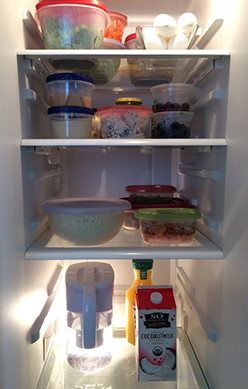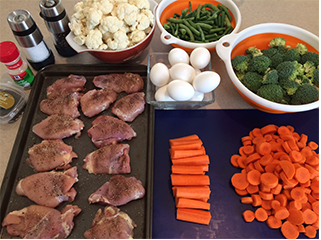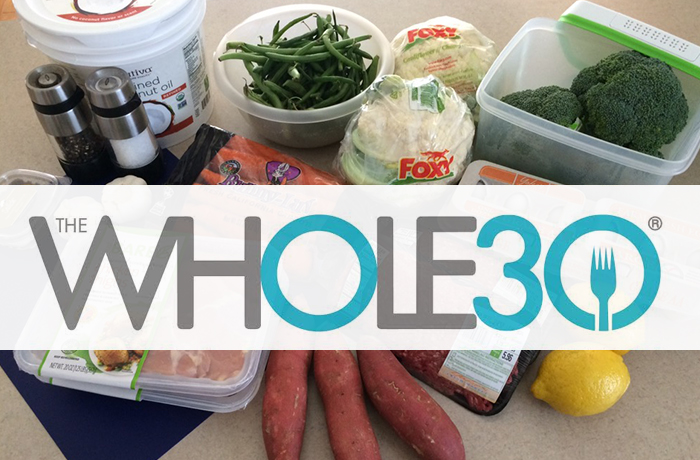The Whole30: for heart health, for life
Posted on September 8, 2016 at 6:00 am
By Jane Baker
The cardiologist gave me a choice: lose weight, lower your blood pressure, and get more cardio exercise or begin taking a prescription. After we talked it through, I made the decision to forgo the medication, and return in six months for a follow-up on how things were going.
“Stay away from carbohydrates, and don’t worry about fat. Fat doesn’t make you fat,” my doctor said.
I understood what he was saying. As a lifelong yo-yo dieter, I am more than familiar with reading labels and watching carbs, fats, and proteins. I experienced it with almost every weight-loss trend and fad to come along since the mid-70s (as with many women, the struggle to be thin began in the early teens).
The doctor was describing a low-carb diet that wasn’t concerned with fat, which sounded like the Paleo diet, “a diet based on the types of foods presumed to have been eaten by early humans, consisting chiefly of meat, fish, vegetables, and fruit, and excluding dairy or grain products and processed food” (source: www.oxforddictionaries.com).
Paleo, clean eating, and whole foods are all trendy right now. I thought, “Hmmm, more trends?” But then I came across this book: The Whole30: The 30-day Guide to Total Health and Food Freedom. No sugar, no grains, no legumes, no dairy, no soy, no alcohol, no baked goods, and no treats. I couldn’t wait to get started. Wait, what?! From the first sentence in the preface, to the closing chapter, this book had me ready to begin the 30-day challenge immediately.

Given my tendency for the latest diet, of course, I would be an easy sell, but that wasn’t the case this time*. The authors only ask for 30 days and even include a timeline on what to expect, and when, during those 30 days. I was up for the challenge.
The tough-love tone of the authors motivated me to follow the plan to a T: clearing all forbidden foods out of the kitchen (and donating to the food bank), restocking with items from the provided shopping list, and even indulging in a nice, new garlic press.
Day One was good. Day Two, good. Day Three…whoa.
For the next two weeks, I would fight through a fog of sugar cravings, spend hours each day in the kitchen following the recipes in the book, making clarified butter and homemade mayonnaise, assembling meals for the next day, and so on. Each night I would be exhausted and grumpy about the fact that healthy eating took so much work.

Then, I had a major shift on Day 16.
The authors call it Tiger Blood. My head was clear, and I was full of energy. Even my hyper dog could barely keep up on our daily walk. It wasn’t just me. I have the wonderful support of my husband who joined me in the challenge, and he, too, experienced the surge in energy around the same time. Tiger Blood got me through the next two weeks, and by day 31, I stepped on the scale (a no-no during the 30 days) and was down 7 pounds!
While happy to have a number measurement for weight loss, this is not the focus of The Whole30. In fact, the authors prefer if you toss out your scale and measure results by how you feel and how you look. One of my favorite lines in the book is, “why let a number ruin your day.”
After the 30 days, you can begin reintroducing foods, one at a time, to see how you feel and how your body reacts. As glad as I was to have made it through the 30 days, I decided to continue with my food freedom—not just to lose weight but because my relationship with food was changing. I had learned a lot about how my body reacts to different foods. Yet I was still resentful about the time and effort required to keep eating Whole30-ish. I knew there had to be an easier way. I turned to the resource section of The Whole30 where I found a listing of compliant cookbooks.
Nom Nom Paleo: Food for Humans by Michelle Tam and Henry Fong was inspiring. Michelle Tam’s whole family, including two young children, were eating Paleo (their recipe for Egg Foo Young is delicious!).
Paleo Perfected/American’s Test Kitchen has several yummy recipes, including a snack granola that’s my husband’s new favorite.
Then I discovered Well Fed by Melissa Joulwan, and the rest of the story fell into place. Well Fed presents the restaurant concept for the home kitchen by doing a weekly cook-up of the basics in one day. Then as the week progresses, it’s just a matter of assembling the protein, vegetables, and desired spices/sauces for each meal.
At first it was daunting to do so much cooking prep in one day. But now every Sunday, I put on my favorite two-hour podcast while I chop, steam, and process five different vegetables, pre-cook beef, chicken, and sometimes lamb, hard-boil a dozen eggs, and otherwise stock my fridge like a restaurant. From these basics, weeknight meals are just a matter of combining the flavors I’m in the mood for in a sauté with occasionally mixing up a stir-fry sauce. And dinner is usually ready in 20 minutes.
My relationship with food has completely changed. Through The Whole30, I’ve learned not only how food makes me feel and what it does to my body, but a new approach for creative preparation.
Call it what you’d like—Paleo, clean eating, whole food, or just crazy—it’s working for me. Four and a half months have passed since Day One, and I’m down over 20 pounds. More importantly, I’m feeling great, my chronic insomnia is gone, my skin looks healthier, and my blood pressure is down. Even my outlook is sunnier. I am actually looking forward to the six-month follow-up appointment with my cardiologist.
*The Whole30 is the second book by authors Melissa Hartwig and Dallas Hartwig and is the how-to follow-up to It Starts With Food that presents the science behind The Whole30, which also includes a recap of the science.
Tags: books, clean eating, cooking, diet, food, heart health, low-carb, paleo, recipes, science, Tiger Blood, whole 30, whole food, whole30


